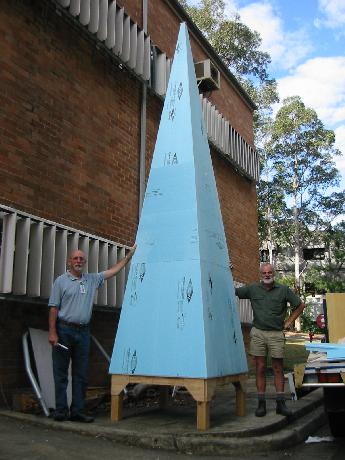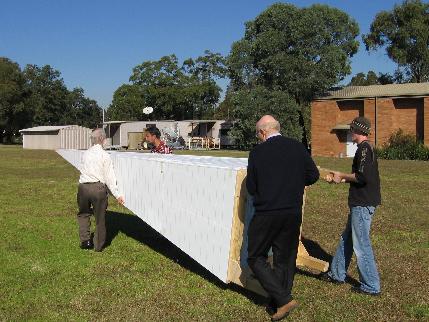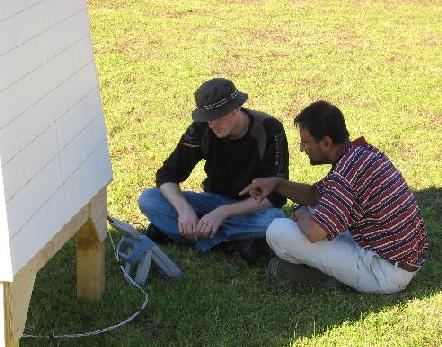Cosmological re-ionization experiment
The ATNF has a project in progress to develop a telescope for the detection of signatures of re-ionization in the early universe. The experiment aims to exploit the extremely low RFI environment at the Mileura site in Western Australia. The execution of this difficult objective would be a strategic development of low-frequency astronomy techniques and a pathfinder to doing useful astronomy from Mileura.
After the baryons recombined at redshift z = 1089, the kinetic temperature of the neutral gas initially followed the CMB radiation temperature and, therefore, the hydrogen was not detectable in redshifted 21-cm transition. The temperatures decoupled at z ~ 200 and, subsequently, the gas is potentially detectable in absorption or emission depending on the neutral fraction in the hydrogen and its spin temperature. The gas would cease to be observable in the 21-cm line once re-ionization was complete at z ~ 6. Many low-frequency radio telescopes have been proposed and are being built with the aim of detecting the spectrum of spatial-frequency fluctuations in this redshift window as a probe of structure formation, re-ionization process and thermal history of the gas during these epochs. We have initiated a project to develop capability for sensitive wide-band measurements of the mean spectrum of the sky at VHF frequencies: the aim here is to detect any features in the all-sky spectrum that might arise from the cosmological evolution in the gas.
 Figure 1: Barry Parsons and Michael McDonald with their creation: the styrofoam structure of the pyramidal antenna. The three-piece pyramid was built in the Marsfield workshop by gluing together precisely cut styrofoam slabs. Photo: Aaron Chippendale
Figure 1: Barry Parsons and Michael McDonald with their creation: the styrofoam structure of the pyramidal antenna. The three-piece pyramid was built in the Marsfield workshop by gluing together precisely cut styrofoam slabs. Photo: Aaron Chippendale
The project is a developmental effort towards a telescope and receiver, that would view the sky with steradian angular resolution, and would be capable of detecting the few mK spectral features that might be present in the background sky that has a brightness exceeding 1000 K. The Galactic diffuse emissions as well as thermal and non-thermal sources in the sky are believed to have smooth continuum spectra; however, angular structure in the sky brightness may result in spurious spectral features if the antenna response varies across the band. Interference can also be a show stopper, either by directly corrupting the entire band or by generating inter-modulation products across the band. Another key issue is the calibration of the spectral response of the system and the subtraction of additive contributions from within the receiver and from the environment. These considerations have led us along a path that uses frequency-independent antennas, a very simple analogue chain, and a multi-bit digital filter bank. Additionally, we adopt correlation techniques to cancel the additive contributions that may have confusing spectral features. In the Mark-1 system that we are working on, the sky signal is split in a power divider immediately after the antenna and the pair of signals is processed via parallel receiver chains and a correlation spectrometer. The roadmap for the project envisages moving the splitter stage up the signal path.
 Figure 2: The finished antenna was taken out to a clearing on the Marsfield site for measurements: Ron Ekers, Ravi Subrahmanyan, Peter Shaver and Aaron Chippendale. Photo: Rob Power
Figure 2: The finished antenna was taken out to a clearing on the Marsfield site for measurements: Ron Ekers, Ravi Subrahmanyan, Peter Shaver and Aaron Chippendale. Photo: Rob Power
We have built a two-arm pyramidal log-spiral antenna to operate over the frequency band 100 – 228 MHz. The antenna was designed to have a structural bandwidth of 20:1 so that the beam pattern would be frequency independent, at the 1% level, over the octave operating band. The support structure is shown in Figure 1 and is a pyramid made using a grade of styrofoam. The structure was designed to be made in three parts that fit together to form the pyramid. Each of these parts is a box frame formed by gluing precision cut slabs of the foam. Ideally we would like to make the pyramidal support structure of materials that are `invisible' at the observing frequencies: we measured the dielectric constant and loss tangents of the foam material and the glue and paint by hanging samples in front of the feed cone of one antenna of the Compact Array while the interferometers observed a calibrator source. The measurements showed that the contributions from the structural materials should be insignificant. Figure 2 shows the completed antenna after the foam structure was painted and a pair of wire arms was put on. The wires may be easily removed and replaced at a remote site with a different pitch angle or with four-arm log-spirals.
The analogue chains have separate couplers for adding calibration noise into the signal path, low-noise amplifiers, filters that limit the band to the range 114 – 228 MHz for the Mark-1 system, attenuators and further amplifier stages. The 8-bit samplers lead to poly-phase filter banks and cross multipliers implemented on a Berkeley S5 spectrometer board: we obtained the spectrometer hardware thanks to Dan Werthimer and his group at Berkeley.
 Figure 3: Aaron and Ravi looking at first tests of the performance. Photo: Rob Power
Figure 3: Aaron and Ravi looking at first tests of the performance. Photo: Rob Power
The lively discussions that explored different concepts have been an intellectually stimulating experience for all those who participated; the wealth of ideas offered from within and beyond the ATNF has been very thought-provoking and motivating. Significant changes in the system design and project plan continued throughout the last year; only the pouring of concrete could stop that. We now have all the bits and pieces on hand and, as seen in Figure 3, are at the critical stage of system integration and debugging. The antenna will be observing at the Mileura station in Western Australia within months and we look forward to interesting times ahead exploring unknown territory while attempting this exceedingly difficult experiment in the outback. This Mark-1 system is our first step towards the re-ionization epoch.
Ravi Subrahmanyan, Aaron Chippendale and Ron Ekers
(Ravi.Subrahmanyan@csiro.au, Aaron.Chippendale@csiro.au and Ron.Ekers@csiro.au)
